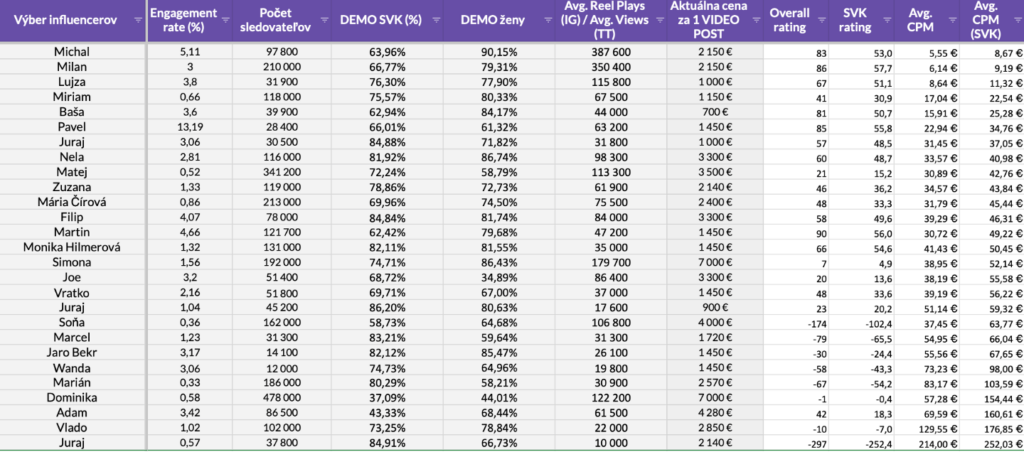
Influencer marketing has become a powerful strategy to reach target audiences and drive sales. By now, you’ve probably heard that it’s an ideal tool for e-commerce businesses to build brand awareness and increase conversions.
However, some brands remain skeptical about its effectiveness. Why doesn’t influencer marketing always work? What mistakes lead to poor results? And how do you set up a collaboration that truly delivers?
To help you navigate this, we’ve put together 10 essential steps for running a successful influencer marketing campaign. This checklist not only outlines the best practices but also reflects key trends shaping influencer marketing in 2025. Follow these steps to maximize the impact of your next e-commerce campaign.
1. Define Your Campaign Goals
Before reaching out to influencers, determine your objectives. Are you aiming to:
✅ Increase sales?
✅ Strengthen brand awareness?
✅ Gain new social media followers?
✅ Launch a new product?
Clearly defined goals help shape your campaign strategy and make performance evaluation easier.
⚠️ Note: Your e-commerce marketing strategy should never rely solely on influencer marketing. It works best when combined with other channels, such as paid advertising and email marketing.
2. Choose the Right Influencers
Don’t base your selection solely on follower count. Instead, analyze an influencer’s:
✅ Engagement rate (likes, comments, shares)
✅ Values (alignment with your brand)
✅ Content themes (relevance to your niche)
Micro-influencers (10K–50K followers) often generate better conversion rates than larger creators—though in some cases, mega-influencers can also deliver strong results.
💡 Pro Tip: When selecting influencers, calculate their average CPM (cost per thousand impressions). If your goal is video content (e.g., Reels), estimate the CPM based on their past performance. This allows for a data-driven selection of the most cost-effective influencers.

3. Know Your Audience
To ensure an effective collaboration, understand who your customers are:
📊 Age, gender, and location
📊 Interests and behaviors
📊 Preferred social media platforms
For example, if your e-commerce store targets both Slovak and Czech customers, partner with influencers whose audience includes followers from both regions. Similarly, if your ideal customers are women, prioritize influencers with a high female follower ratio.
💡 Pro Tip: If you want to target audiences aged 45+, don’t rely on Instagram. This demographic is more active on Facebook.
4. Set a Budget
Influencer marketing can be costly, but a well-planned budget ensures strong ROI. Beyond influencer fees, consider costs for:
💰 Content production
💰 Paid promotions (boosting)
To prevent overspending, negotiate performance-based agreements with influencers. Set clear targets for impressions, reach, or engagement—if they underperform, the influencer might need to create additional content to meet the agreed results.
💡 Pro Tip: Boosting influencer content on your brand’s social media pages significantly amplifies reach. Allocate as much to boosting as you spend on content production for maximum impact
5. Provide a Clear Brief
Influencers need to understand exactly what you expect from them. Your campaign brief should include:
✅ Key messaging and campaign goals
✅ Content formats that work best for the creator’s audience
✅ Product details and deadlines
✅ Creative guidelines (Do’s & Don’ts)
✅ Examples of benchmark content for reference
At the same time, allow room for creative freedom—influencers know their audience best and understand what will drive engagement.
6. Track KPIs & Analyze Performance
After each campaign, evaluate the results to gain valuable insights for future partnerships. Measure key metrics such as:
📊 Clicks on links
📊 Conversions & sales
📊 Follower growth on social media
📊 Engagement rates (likes, comments, shares)
💡 Pro Tip: Always request performance analytics from influencers after a campaign. Include this as a condition before releasing their payment.
Use a tracking sheet to calculate:
✅ CPM (cost per 1,000 impressions)
✅ CPR (cost per 1,000 reach)
✅ CPE (cost per engagement)
This data helps identify which influencers perform best—allowing you to decide who to continue working with and who could become a long-term brand ambassador.
7. Use Affiliate Links & Discount Code
A simple yet effective way to track influencer-driven sales is by assigning them unique:
🔗 Affiliate links
💳 Discount codes
This allows you to directly measure how much revenue each influencer generates.
💡 Pro Tip: Keep influencers updated on how their campaign is performing. They often add extra content to help reach targets if they see their results falling short.
8. Focus on Long-Term Partnerships
One-off collaborations can generate short-term gains, but long-term influencer partnerships build deeper trust and engagement. Benefits include:
✔️ Greater trust from the audience – Repeated promotions feel more authentic than one-off sponsorships.
✔️ Better results – Influencers become more familiar with your brand and create stronger content over time.
✔️ Stronger brand association – Long-term partners can serve as brand ambassadors, increasing credibility.
💡 Pro Tip: Consider exclusivity agreements. If an influencer promotes competitors, it may weaken audience trust in your brand.
A rapidly growing segment in UGC marketing is paid UGC creators—professionals who produce content for brands on demand. Unlike influencers, they don’t need a large following but focus solely on content creation.
Brands can select UGC creators similarly to how they choose influencers, but instead of promoting the content on their own profiles, UGC creators provide content that brands can use for marketing campaigns (e.g., social media ads, product pages, or newsletters). 💸
Despite being paid, this content still appears authentic to consumers, making it an effective marketing strategy.
9. Stay on Top of Trends
Influencer marketing is constantly evolving. Key 2025 trends include:
📈 Growing demand for video content (TikTok & Instagram Reels)
📈 AI-driven content personalization
📈 Emphasis on sustainability & ethical collaborations
📈 Higher audience expectations for authenticity
Consumers are becoming less tolerant of traditional ads and prefer genuine recommendations. This reinforces the importance of long-term partnerships, where influencers truly use and believe in the product.
💡 Pro Tip: Regularly monitor industry trends and engage in discussions to keep your strategy updated.
10. Be Transparent & Follow Advertising Guidelines
Ensure that all influencer collaborations comply with advertising regulations. Consumers appreciate authenticity, but they also want transparency about sponsored content.
💡 Pro Tip: Provide influencers with a clear template for ad disclosures in your campaign brief.
⚠️ Influencer marketing regulations are evolving—resources like the Influencer Marketing Code of Conduct help brands and creators stay compliant.
Influencer marketing is a powerful tool for e-commerce—but only when implemented strategically.
By following these 10 key steps, brands can optimize their approach and achieve stronger engagement, higher conversions, and long-term growth.
Are you ready to take your influencer marketing strategy to the next level in 2025? 🚀





